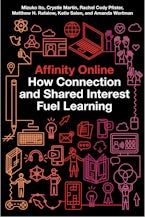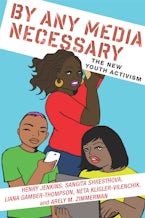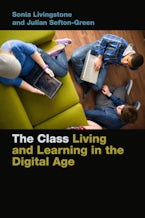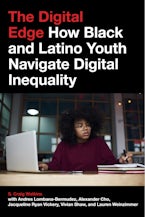This series explores young people’s day-to-day lives and futures. The volumes consider changes at the intersection of civil and political reform, transformations in employment and education, and the growing presence of digital technologies in all aspects of social, cultural and political life. The John D. and Catherine T. MacArthur Foundation’s Digital Media and Learning (DML) Initiative has supported two research networks that have helped launch this series: the Youth and Participatory Politics Research Network and the Connected Learning Research Network. The DML Initiative and the DML Hub at the University of California, Irvine, also support production and open access for this series. Read more about the project...
In this series
Affinity OnlineHow Connection and Shared Interest Fuel Learning
Boyband One Direction fanfiction writers, gamers who solve math problems together, Harry Potter fans who knit for a cause. Across subcultures and geographies, young fans have found each other and formed community online, learning from one another along the way. From these and other in-depth case studies of online affinity networks, Affinity Online considers how young people have found new opportunities for expanded learning in the digital age. These cases reveal the shared characteristics and unique cultures and practices of different online affinity networks, and how they support “connected learning”—learning that brings together youth interests, social activity, and accomplishment in civic, academic, and career relevant arenas. Although involvement in online communities is an established fixture of growing up in the networked age, participation in these spaces show how young people ...
By Any Media NecessaryThe New Youth Activism
There is a widespread perception that the foundations of American democracy are dysfunctional, public trust in core institutions is eroding, and little is likely to emerge from traditional politics that will shift those conditions. Youth are often seen as emblematic of this crisis—frequently represented as uninterested in political life, ill-informed about current-affairs, and unwilling to register and vote. By Any Media Necessary offers a profoundly different picture of contemporary American youth. Young men and women are tapping into the potential of new forms of communication such as social media platforms, spreadable videos and memes, remixing the language of popular culture, and seeking to bring about political change—by any media necessary. In a series of case studies covering a diverse range of organizations, networks, and movements involving young people in the political ...
The ClassLiving and Learning in the Digital Age
Do today’s youth have more opportunities than their parents? As they build their own social and digital networks, does that offer new routes to learning and friendship? How do they navigate the meaning of education in a digitally connected but fiercely competitive, highly individualized world? Based upon fieldwork at an ordinary London school, The Class examines young people’s experiences of growing up and learning in a digital world. In this original and engaging study, Livingstone and Sefton-Green explore youth values, teenagers’ perspectives on their futures, and their tactics for facing the opportunities and challenges that lie ahead. The authors follow the students as they move across their different social worlds—in school, at home, and with their friends, engaging in a range of activities from video games to drama clubs and music lessons. By portraying the texture of the ...
The Digital EdgeHow Black and Latino Youth Navigate Digital Inequality
The Digital Edge examines how the digital and social-media lives of low-income youth, especially youth of color, have evolved amidst rapid social and technological change. While notions of the digital divide between the “technology rich” and the “technology poor” have largely focused on access to new media technologies, the contours of the digital divide have grown increasingly complex. Analyzing data from a year‐long ethnographic study at Freeway High School, the authors investigate how the digital media ecologies and practices of black and Latino youth have adapted as a result of the wider diffusion of the internet all around us--in homes, at school, and in the palm of our hands. Their eager adoption of different technologies forge new possibilities for learning and creating that recognize the collective power of youth: peer networks, inventive uses of technology, and impassioned ...



